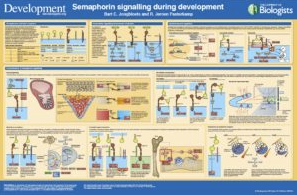Function and signalling of axon guidance cues
One of the most challenging problems in biology is to understand how the billions of neurons in the mammalian nervous system “wire up” to form functional neural circuits that underlie all behaviour. This has been one of the most intensely studied areas of developmental neurobiology in the past, and a number of important proteins have been identified that instruct axons to project to their specific target regions (so called axon guidance proteins).
Our current work focuses on how axon guidance proteins are detected by receptor proteins on growing axons, how these receptors signal and how they are regulated by for example endocytosis or proteolytic cleavage. Remarkably, our nervous system contains billions of connections but no more than a hundred axon guidance proteins. How can this relatively small number of proteins set up the wiring of a disproportionally large number of connections with many different characteristics such as trajectories or synaptic partners? Evidence is emerging that the effects of axon guidance proteins are diversified and spatiotemporally controlled, vastly expanding the number of guidance decisions they can mediate.
However, the molecular details of this regulation and its relevance for vertebrate axon guidance in vivo remain incompletely understood. Another aim of our work is therefore to resolve key molecular events that enable a limited number of axon guidance proteins to dictate a vast number of wiring decisions in vivo. This work is in part supported by a VICI grant from ALW-NWO.

Axon guidance
Scan de bovenstaande QR-code met uw telefoon om een video over dit onderwerp te bekijken. Of bekijk de video via:
